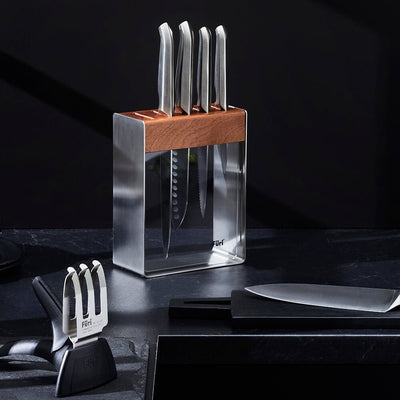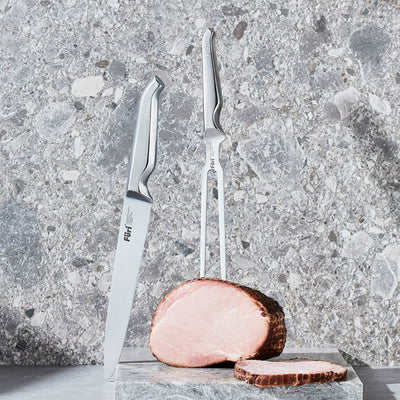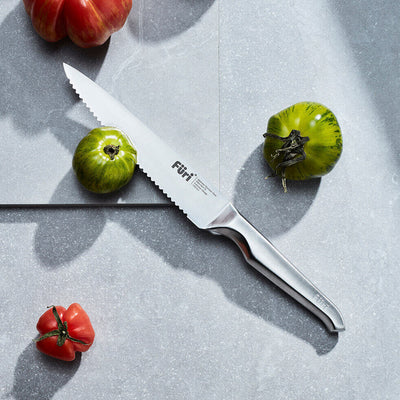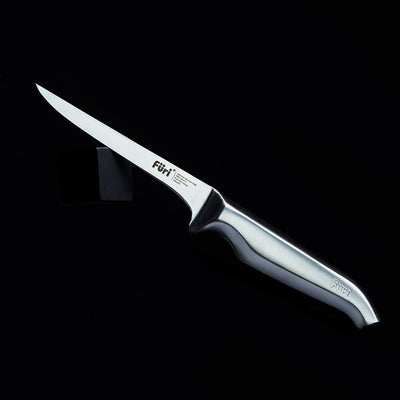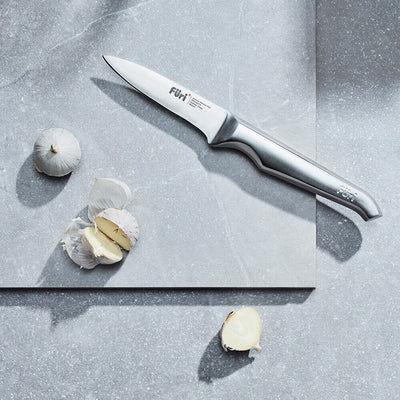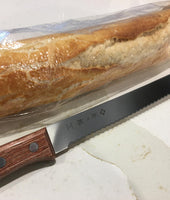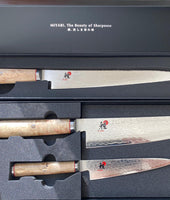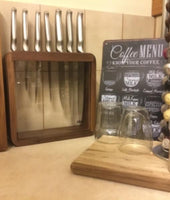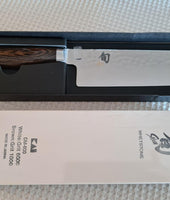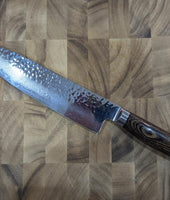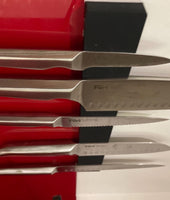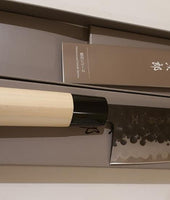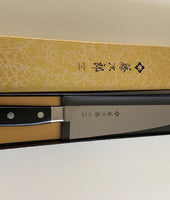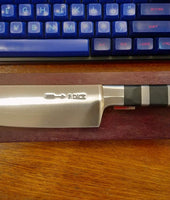
With many different designs, sizes, blade shapes, and brands it can get confusing how to separate each knife apart and understand what each is designed to do.
We have cleared the air by...
- Putting together a grid which clearly lays out what each knife does, it's purpose, and any unique characteristics they have.
- Including further information as well as example pictures and links of each knife underneath.

The brilliant infographics are thanks to the team at FIX.com

Chef Knife
The bread and butter of any professional chef or cook enthusiast culinary tools would have to be the multi-purpose chef knife.
The chef’s knife is usually designed with a 6 to 14-inch blade length with 8 inch as the most popular length. A multi-purpose knife designed to perform well at a number of tasks as opposed to specialising in any one purpose.
It has a wide, triangular blade and a curved belly for an easy rocking motion when cutting.
They are used for mincing, slicing meat, chopping vegetables and disjointing large cuts. A must-have in any kitchen.
Browse our range of Chef knives here
Santoku Knife
Typically smaller, thinner and lighter than Chef Knives, the name Santoku is translated to ‘three virtues’ symbolizes the characteristics of this knife – chopping, dicing and mincing.
Sometimes come with (scalloped) Granton edges which add air between the knife blade and the food being cut, preventing any food pieces from getting stuck to the blade. This particularly comes in handy when making thin cuts.
Comes with a slightly curved blade for easy mincing.
The Santoku knife is also a great all-purpose knife and may be more comfortable for people with smaller hands allowing you to chop food with ease.
Browse our range of Santoku knives here
Utility Knife
Midway in size between a Chef's knife and a Paring knife, they are designed for cutting mid-sized fruits and vegetables, slicing cheese, small cuts of meat and sandwiches not quite large enough for a Chef knife.
They are versatile and have a narrower blade than a cook’s knife. They come with a straight or serrated edge and are typically 5-7 inches in length.
Browse our range of Utility knives here
Nakiri (Vegetable) Knife
A Japanese styled knife used for chopping vegetables, it is distinguished by its straight blade edge. This knife allows the user to cut all the way through vegetables with ease without the need of any horizontal push and pull.
Browse our range of Nakiri knives here

Paring Knife
A small knife with a plain edge blade, these knives are perfect for peeling fruits and vegetables or for small delicate work i.e. slicing a single garlic clove, de-veining a shrimp, cutting shapes into dough and so forth.
They are very versatile and one of the most used knives in a chef’s kitchen. Typically ranges from 2-4 inches long.
Browse our range of Paring knives here

Cleaver
Generally used as a kitchen or butcher knife for hacking through meat and bone and for overall heavy-duty cutting. Comes with a large, rectangular blade.
The broad side can be used for crushing when preparing foods such as garlic.
Typically ranges from 6-10 inches long.
Browse our range of Cleavers here

Boning Knife
With a narrow blade and a sharp point, this knife is designed for removing the bones of poultry, meat, fish.
Usually comes with a flexible blade, the long and narrow profile that curves at the base and up near the tip is designed to follow the contours of bones and cartilage.
Browse our range of Boning knives here

Bread Knife
With a sharp and serrated blade designed for cutting smooth or hard surfaces, examples including tomatoes, salami, bread and the like.
Typically ranges from 8-10 inches long.
Browse our range of Bread knives here
Which Chopping Board is Best for Your Knife? A Comparison.
Whether you are a busy homemaker or a pro chef, kitchen knives are the most important tools for your routines. It should be in your best interest to bring out the best in food when cooking, whether for your loved ones or customers. However, this tool cannot function well without a good quality cutting board.
Chopping boards are designed to place your food against something solid so that the knife can slice the material with ease. While choosing a chopping board, it is important to ensure that it should minimize the wear and tear to the knife blade edges.
No one likes dull blades as it leads to uncontrolled motion while slicing food and may even lead to serious accidents. In order to choose the best chopping board suited to your needs, it is first important to compare the available options and the pros and cons of each.
1. Bamboo:
You can find many chopping boards made of bamboo material, but this hard material can damage the blades of your knife, especially when it is made up of softer steels. They can even dull the hardest Japanese knives; hence, are not commonly recommended to professionals.
Pros:
- They come with an organic feel.
- Cheaper option.
- Made up of renewable sources.
Cons:
- Not good for knife edges.

2. Composite:
These cutting boards are made up of various substances such as compressed cardboards, recycled papers or harvested wood fiber, etc. They come in thicker and heavier form but are considered as a better choice than glass chopping boards as composite materials are safe for your knives.
Pros:
- Moderately priced.
- They do not suffer from warping.
- Made up of recycled materials.
Cons:
- Some people reported odor and flaking issues.
- The thicker versions tend to be costlier.
- Wood-based models are not good on kitchen knife edges.
3. Plastic:
The plastic boards are available in a variety of colours and styles. Moreover, they weigh less compared to wooden boards. Some people consider them the best choice for modern home décor. But they are harder on kitchen knife edges so cannot be considered as the primary choice.
Pros:
- Most of these products are dishwasher safe.
- Comparatively good for maintaining knife sharpness.
- Many of these are made up of recycled materials.
Cons:
- Most of these models are not usable as hot pads.
- The thin or light models cause slipping on counters.

4. Wooden:
By all means, wooden cutting/chopping boards are the best choice for every home. But the only trouble with them is that they are less hygienic. However, proper care and cleaning routines can ensure a healthy solution for the long run. Wooden boards are also the best choice to save knife edges; they maintain blade sharpness for a longer time.
Pros:
- Organic look that suits every home décor.
- They do not slide over counters.
- Wooden chopping boards can maintain edges of your knives.
- Made up of renewable sources.
Cons:
- Must be hydrated from time to time.
- Need proper cleaning routine to ensure desired hygiene level.

5 Mistakes That Could Be Damaging Your Knives
When it comes to meal preparation, the chef’s knife is the most valuable tool in the kitchen. But for those that aren’t properly skilled in the use of the knife like a professional, it is not uncommon to make a few mistakes when using their knives.
Even just a few small repeated mistakes can dramatically reduce the overall lifespan of your knives. Hence, it is important to be aware of what type of mistakes you need to avoid.
Do you make any of the 5 mistakes below when using your knives? Avoid these and you’ll keep your precious knives sharp, mean, and keen for many years to come.
Stop cutting on the wrong surface:
As it is important to choose the right knife for chopping, dicing and slicing, you must also be wary of what surface you are cutting on as well. Cutting food on hard surfaces such as ceramic or glass chopping boards may cause potential damage to the blades, dulling then over time.
Moreover, working on an unsecured board; one that may slide or slip may also cause additional damage to the knife and increases your chances of harming yourself. It is advised to work on plastic or wooden cutting boards which absorb some of the impact with each cut and ensures longer life performance for your kitchen knives.
Holding knives improperly:
Using the incorrect grip when holding a knife may lead to less stable and uncontrolled movements. Not only does this cause the blade more stress as it is not cutting at the angle that it was intended for, but it makes preparing food more strenuous and increases the chances of injury.
For delicate and finer cuts Japanese knives are recommended, while German knives are the power horses and suited to cutting thicker and tougher food items.

Cutting food with the wrong part of the knife blade:
A knife is not limited to the handle and blade only; there are many more important parts and each of them plays an essential role in cutting or chopping. By failing to use the right part of the blade when cutting can end up damaging them over time.
In general, there are four essential parts of a chef’s knife; they include the heel, tip, point, and edge.
The tip of Japanese knives are dedicated to delicate tasks such as scoring and piercing the food. The heel is essential for cutting hard ingredients such as winter squash and carrots; whereas the spine or edge is designed for scraping chili, tomato, and vanilla beans, etc.
Using a knife with a dull blade:
A dull knife is a dangerous knife, no doubt about it. With a dull blade, you will be forced to exert a lot more power to get the same cut and the blade may slip when cutting or chopping food. Both of which are a recipe for an accident waiting to happen.
It is important to hone and sharpen your kitchen knives from time to time to keep the blade in optimal condition.
Not using proper storage space:
Throwing your knives into a drawer with all your other cutlery will cause the blade to dull every time it bangs against other items. It is recommended to have a dedicated space for your kitchen knives, either it be in a drawer, knife block or magnet strip attached to your wall.
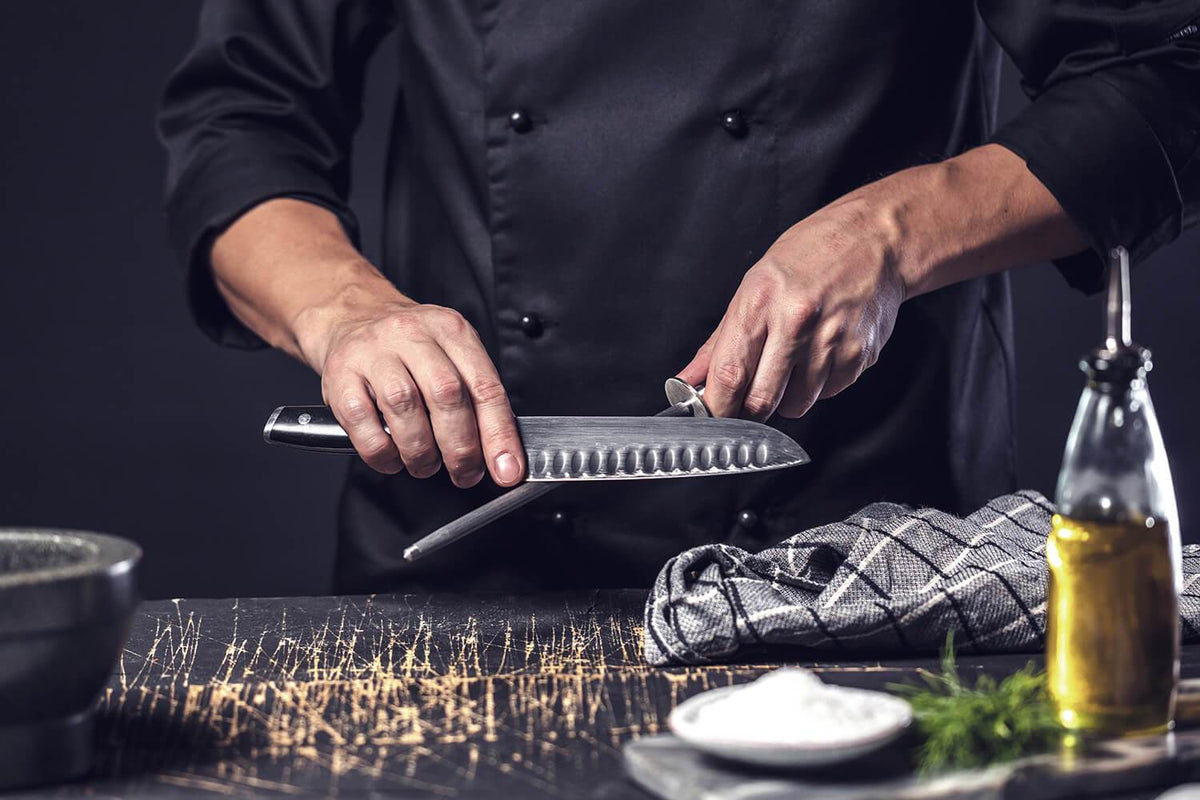
Knife Care 101
Carbon steel knives:
- Considered to be a superior steel for kitchen knives due to the superior sharpness that can be obtained, edge retention, and ease of re-sharpening.
- They do however need to be cleaned, dried and oiled after use, to prevent rust.
- All carbon steel blades will patina (change colour, usually by darkening) over time and with use. Food items such as most fruits, vegetables and meats in particular will cause the formation of patina.
- Patina will over time help prevent the rusting of the carbon steel.
How to clean your knives:
- Protect your investment by handwashing your blades with gentle dish soap.
- Don’t use soaps with citrus extracts or bleach; they can promote corrosion. Do not use scouring pads, steel, or gritty cleanser when cleaning the blades. Rinse and towel dry immediately.
- Let the knives air dry for a few minutes before returning them to storage. Never leave your knife sitting in a sink full of soapy water.
- After you have washed and dried your knives, store them in a block, knife case, in-drawer tray, or sheath. Make sure they are stored in a dry, moisture-free place to avoid rusting or discolouration
- We do not recommend storing the knives unsheathed in a drawer, as this can be a potential hazard to the blades as well as your fingers.
- Under no circumstances should a finely honed and highly polished blade comes into contact with other hard materials such as metals, ceramic or stone.
Preserve your knives from rust and oxidization, and preserve your wooden handles with camellia oil. It is also good protection for the blade but generally must be removed from the blade before cooking.
Wood is a living natural material and loves a little care. From time to time rub a few drops of oil onto the wooden handles of your knives. The wooden chopping boards should be cared for with oil too. With the special Swedish linseed oil, the wood keeps its original beauty and individual radiance.
Caution
- Please do not use the knife in a twisting motion.
- Select the correct knife for the task to ensure you will get the best cutting results and you are also easy on the blades
- Please use a soft plastic or wooden cutting board to protect the edge of the blade.
- Please don't heat or cool rapidly as it may change the structure of the steel.
- The handle colour may change slightly over time due to oils in the hand as well as the natural colour change of wood from oxidation and/or exposure to light. This is not a defect, but a natural part of the process.
Sharpening vs Honing, and Best Practices
Sharpening vs Honing:
- Sharpening fixes any chips and wear on the blade by removing small amounts of metal from the edge of the blade to return its sharp edge. Depending on how often the knife is used, you should only need to sharpen once ever few weeks or less.
- Honing on the other hand, realigns the blade to ensure you are cutting with a straight edge and should be done ideally once a week or more to extend the longevity of your knives.
Choosing a Sharpener:
- Is the best way to sharpen a knife, a whetstone acts like sand allowing more blade movement and sheds the least amount of metal.
- Respects the shape of the blade, important for Japanese knives which have a tapered V-shaped edge. Whetstones which are freestanding allow you to use both hands to press the blade against the stone to determine the exact angle.
- Keeps your knife in top condition, and ensure it lasts for the longest possible time.
- Using a whetstone is a process. You’ll need to soak it in water for 10 minutes, then sharpen both sides (unless it is a single bevel), and then honing both sides of the blade can take 30 minutes.
- As it is much harder/inflexible than a stone, it sheds more metal when sharpening the blade. However, it is much less abrasive than a pull-through sharpener.
- Quick and convenient to use. No preparation is required.
- Use on Western knives, it is not recommended on Japanese knives which are typically made of harder steel and have a tapered V shape. The contact of a Japanese blade which is more brittle on a sharpening steel can cause it to chip.
- It is difficult to get the angle correct when using a steel. One hand is required to hold the handle of the steel, while the other hand holds the knife compared to a whetstone which allows you more control.
- Quicker to use than whetstones and more precise than sharpening steels.
- Sheds the most amount of metal, however, shortening the lifespan of the blade.
- Pulling a knife through the sharpening slot, grinds the blade to a pre-set shape. This makes it super sharp instantly and re-aligns the blade to its original shape. That’s why it is important to use a pull-through sharpener that is compatible with your knife. Using a pull-through sharpener within the same brand as your knives are your safest bet.
- For the most part, they cater to Western blades which have straight edges and a pointed tip. Not recommended to use on Japanese knives.
Choosing the right whetstone:
Whetstones have been developed to cater for the needs of enthusiastic cooks to professional chefs and are available in a wide range of abrasive grades:
- Coarse (#220-#400) for repairing chips and reshaping the blade
- Medium (#800-#1000) for regular edge maintenance
- Fine (#3000-#8000) for polishing and honing to a razor finish
Guide to Whetstone Sharpening:

Also Read: Shun Knives, Shun Classic - What is a Shun knife used for?






























